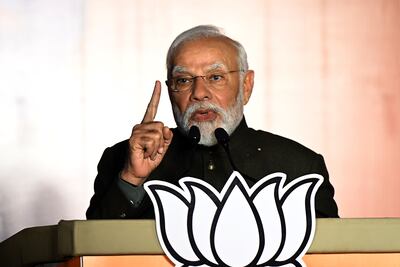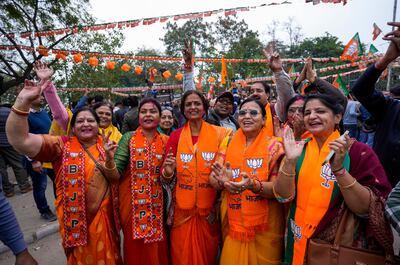Indian Prime Minister Narendra Modi’s Bharatiya Janata Party (BJP) has swept assembly elections in three of four key states, strengthening his grip over the country's heartland and putting him in pole position to win a third consecutive term in the general election in four months.
Although state elections have previously had little bearing on the general elections in India, results in Madhya Pradesh, Rajasthan, Chhattisgarh and Telangana – collectively a sixth of India’s 945 million voters – are a strong indicator of public mood before 2024's electoral battle.
Here are five key takeaways on how the BJP achieved its latest electoral victories.
Modi magic at work
Mr Modi's popularity was an important factor in wins in the regional elections, long seen as a litmus test for him and his party. The victories reinforced his status as a charismatic leader and the party's biggest vote-getter, experts say.
The decisive results set the stage for the party to comfortably retain power in the parliamentary elections, said Madhavi Arora, lead economist at Emkay Global Financial Services.
“It shows the success of the BJP's tactic of projecting Prime Minister Modi as the face of the campaign, especially in Madhya Pradesh – thus reinforcing its position on the front foot,” she said.
The BJP snatched Rajasthan and Chhattisgarh from the main opposition Indian National Congress party in straight contests on Sunday and retained power in the central state of Madhya Pradesh, showing that Mr Modi retains his appeal among voters despite any economic hardship they may have experienced under his leadership.
Weak opposition
The Congress party failed to build on the momentum from its electoral victory in Karnataka in May as it won only in Telangana, another southern state.
The party's wipeout in northern and Central India is viewed as a blow to efforts to become the main challenger to the BJP in the general election.
“Now that Congress has lost heartland states, their chances of being able to give a challenge to the BJP becomes much more feeble,’’ said Rahul Verma, a fellow at the New Delhi-based Centre for Policy Research.
Losing control of the governments in Rajasthan and Chhattisgarh deprived the party of influence and resources that would have helped it in the parliamentary polls.

There was little that worked for the Congress in India's Hindi-speaking heartland – from demanding a census of people in each layer of its caste hierarchy, to welfare measures, to party leader Rahul Gandhi’s nationwide march – as it did not pursue aggressive campaigns, failed to forge alliances with regional parties and could not properly explain its welfare promises to people.
The electoral rout also brings more complications to the Congress-led opposition alliance seeking to defeat the BJP next year as other members could question the party’s ability to win votes.
As the Congress refused to share some seats for alliance partners to fight elections together, they could now be reluctant to be part of the opposition alliance, Mr Verma said.
BJP muscle
The Congress had appeared set to gain the most from the four state elections, but the BJP turned things around with a strong push launched three weeks before voting began.
Mr Modi led the campaign, while the election strategy was managed by central leadership and the party’s poll machinery worked in overdrive.
It shows the party's organisation remains robust, its cadres are motivated and its ability to go the last mile with voters remains intact, said Arati Jerath, a New Delhi-based political analyst.
“The BJP has a formidable election machinery,” she said. “They can get their voters out to polling booths and enthuse cadres. Congress lacks in all of these.”
The BJP is expected to offer more welfare measures, such as health insurance and affordable homes for the poor in 2024, as well as aggressively highlighting its religious nationalism narrative.
Modi’s 'guarantee'
The Congress focused its campaign on freebies and welfare programmes to win the support of farmers, women and underprivileged people, but voters did not find them substantial enough.
What voters do believe in is Mr Modi’s “guarantee” – his assurance to provide financial assistance to women, subsidised cooking gas and free trips to Ayodhya in Uttar Pradesh to visit the under-construction Ram temple.
“I humbly tell our sisters and mothers that promises we have made will be fulfilled 100 per cent,'' said Mr Modi on Sunday as hailed his party's election performance.

“This is Modi's guarantee and Modi's guarantee means the guarantee is fulfilled.''
It shows people view him as a strong leader who they can trust, said Ms Jerath.
“Brand Modi has a huge appeal that caught the people's imagination,'' she said.
Female voters
Those women will have a huge role to play in any election success by Mr Modi. The Axis My India exit poll showed that, in Madhya Pradesh and Chhattisgarh, more women voted for the BJP than the Congress party.
While both parties offered gas subsidies and cash handouts, women supported Mr Modi.
The BJP has received more support from women in past elections in Uttar Pradesh, Uttarakhand and Assam, said Mr Verma.
As female-centred welfare measures were initiated at federal and state level, the BJP became the party of choice for women, he said.
“This is also because of the charismatic appeal of Mr Modi and Uttar Pradesh Chief Minister Yogi Adityanath,'' he said.
